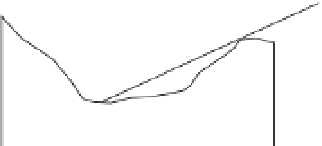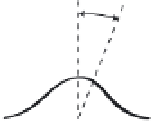Geology Reference
In-Depth Information
Box 3.1
An
in situ
cosmogenic radionuclide primer.
Cosmic ray particles are isotropically
distributed as they enter the Earth's atmos-
phere. The atmosphere attenuates this
production such that the particle flux is lower
from higher zenith angles,
q
(as shown by
the curve in figure A). On a flat surface, they
would produce cosmogenic radionuclides at
a rate
P
0
. Any intervening rock also blocks
production (called topographic shielding),
reducing the effective surface production
rate to below
P
0
(see figure A). Measurement
of this effect is accomplished in the field by
documenting the shielding angle,
j
, in four
to eight directions. The sample site, at a
depth
z
= 0, may be eroding at a long-term
rate of
e
.
concentration is equivalent to that which the
parcel of rock would have obtained had it sat
on the surface for a time
z
*/
e
equal to the
time that it takes for the rock to be exhumed
from a depth of
z
* at a rate
e
(depicted by the
gray box in figure B).
B
z
0
Steady Erosion
z=0
z
*
P=P
0
P=P
0
/e
N=P
0
z
*
/
ε
cosmic ray particles
A
z
*
/
ε
0
Time before sampling
cosmic ray flux
as a function of
zenith angle,
θ
B. Sample histories, for the case of steady erosion.
θ
Conservation of nuclides requires that
the rate of change of concentration,
N
,
equals the rate of production less the rate
of decay:
ϕ
2
ϕ
1
z
ε
bedrock
d
N
=
Pt
()
−
λ
N
A. Topographic shielding of cosmic rays.
d
t
Production rate,
P
, decays exponentially with
depth,
z
, below the instantaneous surface
(see figure C) as
The case of steady erosion
As the depth of the sample decreases owing
to erosion of the overlying rock, the producti
on rate increases exponentially (see figure B).
The concentration therefore increases expo-
nentially. The concentration of a “parcel” of
rock sampled at the surface is equivalent to
the integral of the production rate history.
The sample concentration is higher for
slower erosion rates and for higher local
production rates,
P
0
. Note that the sample
=
−
zz
/*
PP
0
e
where the surface production rate,
P
0
, is
scaled by elevation and geomagnetic latitude.
The rate of decay beneath the surface is
scaled by the length scale
z
* (see figure C),
which is roughly 50-60 cm for most litholo-
gies. The depth can vary with time,
z
(
t
),
owing to either erosion or deposition.







































































